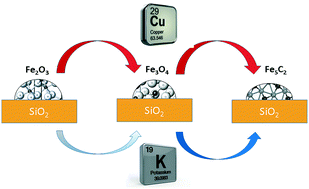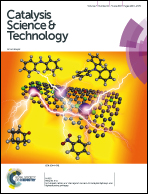Influence of copper and potassium on the structure and carbidisation of supported iron catalysts for Fischer–Tropsch synthesis†
Abstract
This paper addresses the effect of promotion with copper and potassium on the carbidisation kinetics, structure and performance of silica supported iron catalysts for high temperature Fischer–Tropsch synthesis. The promotion with copper and potassium results in the enhancement of iron dispersion. Small hematite nanoparticles were uncovered in the calcined iron catalysts. Activation of the calcined catalysts in carbon monoxide or syngas results in the reduction of hematite to magnetite at 250–300 °C. The magnetite is then carbidised into Hägg iron carbide. The promotion with copper and potassium affects the rate of the iron reduction and carbidisation. Copper strongly enhances both hematite reduction and magnetite carbidisation in carbon monoxide and syngas. The presence of potassium hinders reduction of hematite to magnetite. Much higher reaction rates were observed on copper-promoted catalysts than on the potassium-promoted and unpromoted counterparts while the promotion with potassium had a stronger impact on the selectivity.



 Please wait while we load your content...
Please wait while we load your content...